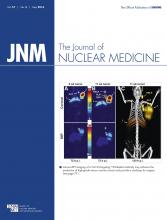Abstract
A reliable prediction of a pathologic complete response (pathCR) to chemoradiotherapy before surgery for esophageal cancer would enable investigators to study the feasibility and outcome of an organ-preserving strategy after chemoradiotherapy. So far no clinical parameters or diagnostic studies are able to accurately predict which patients will achieve a pathCR. The aim of this study was to determine whether subjective and quantitative assessment of baseline and postchemoradiation 18F-FDG PET can improve the accuracy of predicting pathCR to preoperative chemoradiotherapy in esophageal cancer beyond clinical predictors. Methods: This retrospective study was approved by the institutional review board, and the need for written informed consent was waived. Clinical parameters along with subjective and quantitative parameters from baseline and postchemoradiation 18F-FDG PET were derived from 217 esophageal adenocarcinoma patients who underwent chemoradiotherapy followed by surgery. The associations between these parameters and pathCR were studied in univariable and multivariable logistic regression analysis. Four prediction models were constructed and internally validated using bootstrapping to study the incremental predictive values of subjective assessment of 18F-FDG PET, conventional quantitative metabolic features, and comprehensive 18F-FDG PET texture/geometry features, respectively. The clinical benefit of 18F-FDG PET was determined using decision-curve analysis. Results: A pathCR was found in 59 (27%) patients. A clinical prediction model (corrected c-index, 0.67) was improved by adding 18F-FDG PET–based subjective assessment of response (corrected c-index, 0.72). This latter model was slightly improved by the addition of 1 conventional quantitative metabolic feature only (i.e., postchemoradiation total lesion glycolysis; corrected c-index, 0.73), and even more by subsequently adding 4 comprehensive 18F-FDG PET texture/geometry features (corrected c-index, 0.77). However, at a decision threshold of 0.9 or higher, representing a clinically relevant predictive value for pathCR at which one may be willing to omit surgery, there was no clear incremental value. Conclusion: Subjective and quantitative assessment of 18F-FDG PET provides statistical incremental value for predicting pathCR after preoperative chemoradiotherapy in esophageal cancer. However, the discriminatory improvement beyond clinical predictors does not translate into a clinically relevant benefit that could change decision making.
Footnotes
Published online Jan. 21, 2016.
- © 2016 by the Society of Nuclear Medicine and Molecular Imaging, Inc.







